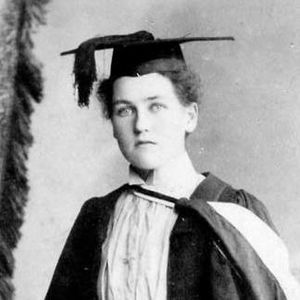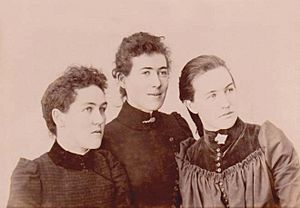Stella Henderson facts for kids
Quick facts for kids
Stella May Henderson
|
|
|---|---|

Henderson at the time of her graduation in 1893
|
|
| Born | 25 October 1871 Kaiapoi, New Zealand
|
| Died | 1 March 1962 Melbourne, Australia
|
| Alma mater | Canterbury College |
| Known for | First woman Parliamentary newspaper reporter in New Zealand |
| Relatives | Elizabeth McCombs (sister); Christina Henderson (sister) |
Stella May Henderson (born October 25, 1871 – died March 1, 1962) was a smart and determined woman from New Zealand. She was a university graduate and a journalist. Stella was also a feminist, which means she believed in equal rights for women. She made history by becoming the first woman to report on Parliament for a big New Zealand newspaper.
In 1903, Stella moved to Australia with her husband. He got a job at a newspaper called Melbourne Argus. A few years later, in 1907, the newspaper asked Stella to write articles. These articles were for a special event called the Australian Women's Work Exhibition. This was the first event of its kind!
Stella started writing a regular column for the newspaper. She used the pen name "Vesta" and called her column "Women to Women." In this column, she wrote about many topics important to women and community well-being. She also became the president of the Women Writers' Club. In 1912, she helped start the Lyceum Club and later became its president too.
Stella retired to England in 1939. Even then, she kept writing for The Argus. She wrote about how World War II affected women and children. In 1947, she moved back to Melbourne and lived there until she passed away in 1962. Stella came from a talented family. Her sister, Elizabeth McCombs, became the first woman Member of Parliament in New Zealand. Another sister, Christina, was a teacher and worked to help society.
Early Life and Education
Stella Henderson was born in Kaiapoi, North Canterbury, New Zealand. Her birthday was October 25, 1871. She was the seventh of nine children born to Alice and Daniel Henderson. Her family lived in Ashburton for some years. When Stella was 11, her family moved to Christchurch.
She went to Christchurch Girls' High School. The principal there was a famous woman named Helen Connon. In 1888, Stella won a special scholarship to Canterbury College. She studied hard and earned two degrees: a Bachelor of Arts and a Master of Arts. She graduated in 1893 with top honors in English and Latin.
Stella first wanted to become a lawyer. However, at that time, women were not allowed to practice law. A kind man named William Izard hired her to work at his law firm. She worked there while still taking classes at Canterbury College. Mr. Izard then talked to a local politician, G.W. Russell. He asked Russell to create a new law to let women become lawyers.
This new law, called the Female Law Practitioners Act, was passed in 1896. Stella then passed her final law exams in 1898. During this time, Stella also developed strong beliefs about society. She and her sisters, Elizabeth and Christina, joined a group that wanted to make society fairer for everyone. They also joined the National Council of Women of New Zealand. This group worked for women's rights. They all signed the petition for women's suffrage. This petition helped New Zealand women win the right to vote in 1893.
Stella's Journalism Career
Just as Stella was ready to start her law career, she got an exciting job offer. The Lyttelton Times newspaper asked her to be their parliamentary reporter. This meant she would report on what happened in Parliament. The newspaper's editor, Samuel Saunders, had noticed Stella. He had seen her speeches and writings for a small political group she was part of.
Saunders told the Press Gallery committee that Stella would use the newspaper's seats. The Press Gallery was where reporters sat in Parliament. But the committee members voted against letting a woman join them. Stella didn't give up! She bought a ticket to the Ladies Gallery in Parliament. She took notes on her knees and wrote her reports in the ladies' tearoom. Then, she sent her reports to her editor every evening.
The male reporters kept complaining about Stella being there. But her employers argued that stopping her from joining the Press Gallery was unfair. It stopped them from hiring who they wanted. The National Council of Women also supported Stella. They asked the Speaker of the House, Sir Maurice O'Rorke, to let Stella into the Press Gallery.
Because of this, a part of the Ladies Gallery was changed into a press gallery just for Stella. She continued to report from Parliament for two years. She left her job when she got married. Her husband was a reporter for a newspaper that had different political views. Stella and her husband felt they couldn't both work for newspapers with such opposite ideas.
Instead, Stella became a reporter for the Brisbane Courier newspaper. In 1903, she and her husband moved to Melbourne, Australia. The next year, Stella started working for The Argus newspaper. At first, she wrote reviews of books. In 1907, she was asked to write a series of articles. These articles were about the first Australian Women's Work Exhibition.
In 1908, she started her weekly column called "Woman to Woman." She used the pen-name "Vesta." In this column, she gave advice and information. She wrote about community issues and topics important to women and children. Stella also joined the Women Writers' Club in Melbourne. She was also one of three women who helped start the Australian Journalists' Association. In 1912, she helped create the Lyceum Club, and later became its president.
In 1939, Stella retired and moved to England. She continued to write for The Argus newspaper. She wrote about how World War II affected women and children. In 1947, she returned to Melbourne. She lived there until she passed away in 1962. A street in Canberra, Australia, is named Vesta Place in her honor.
Stella's Family Life
In 1900, Stella married Edwin Frank Allan. He was also a writer for a newspaper called the Evening Post. Stella and Edwin had four daughters. Their names were Helen Mary, Frances Elizabeth, Stella Patricia Grace, and Alice Margaret.


